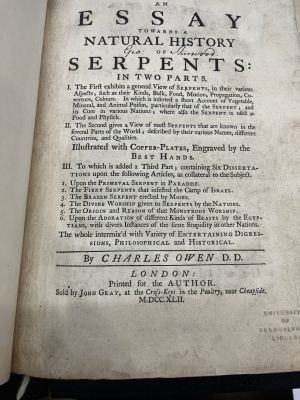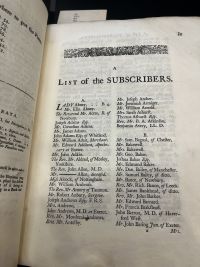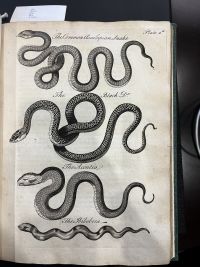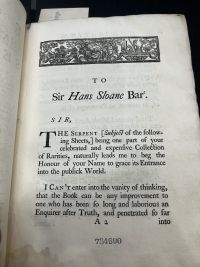Natural History of Serpents: Difference between revisions
| Line 20: | Line 20: | ||
=== Sir Han's Sloane === | === Sir Han's Sloane === | ||
A very interesting part of this book is that there is a dedication to Sir Hans Sloane. Sir Hans Slone was a physician by trade but was also a collector of objects from around the world. <ref> British Museum, ''Sir Has Sloane'', retrieved May 8 2023 from https://www.britishmuseum.org/about-us/british-museum-story/sir-hans-sloane </ref>. Slaone collected more than 71,000 items and it became the founding collection of the British museum <ref | A very interesting part of this book is that there is a dedication to Sir Hans Sloane. Sir Hans Slone was a physician by trade but was also a collector of objects from around the world. <ref> name = "one", British Museum, ''Sir Has Sloane'', retrieved May 8 2023 from https://www.britishmuseum.org/about-us/british-museum-story/sir-hans-sloane </ref>. Slaone collected more than 71,000 items and it became the founding collection of the British museum <ref name = "one" />. This dedication sparks the idea that this book was in fact a science book. | ||
=== Late 1800 Science === | === Late 1800 Science === | ||
Revision as of 00:07, 9 May 2023
An Essay Towards A Natural History Of Serpents is a book by Charles Owen published in 1742 in London. The book is broken down into three parts: The first part talks about a general view of serpents such as their motion, diet, habits, and physical features. The second part gives a View of serpents known in several parts of the world described by their names, countries, and qualities. Finally, The third part contains six dissertations that are collateral to the subject of the book. The book contains seven copper plate engravings, due to the high cost of having copper plate engravings, a solution was to incorporate subscriptions to help aid the printing of this book. The pages were most likely made from rags or linen. With the coming of a new scientific publishing era, this book shows a prime example of a mix of both science and religious attributes and gives an insight on how early science books/papers were written.

Usage


Audience and Circulation
The audience was anyone who had an interest in serpents. It was written in a way that doesn't exclude anyone from reading it. Audiences could have ranged from collectors to students interested in researching serpents. The precise detail of the copper plate engravings also added features that could be enjoyed by various audiences. When it comes to circulation, the front title states "Sold by John Gray, at the Cross-Keys in the Poultry, near Cheapside". So, in the beginning, circulation started by being sold near Cehapside. Another audience and source of circulation comes from the people that subscribed to the printing of this book.
Subscriptions
Due to the high costs of printing, authors came to subscribers for financial help. Similar to subscriptions today, subscribers would financially help by donating money and in return have their names in the book as a subscriber and usually also get a copy of the book after printing. This book had many subscribers. This was due in part to how expensive the copper plate engravings were. This book contains seven engravings so printing a lot of copies would cost a lot of money. Thus, these subscribers would be some of the first people to start the circulation of this book.
Historical Significance

Sir Han's Sloane
A very interesting part of this book is that there is a dedication to Sir Hans Sloane. Sir Hans Slone was a physician by trade but was also a collector of objects from around the world. [1]. Slaone collected more than 71,000 items and it became the founding collection of the British museum [2]. This dedication sparks the idea that this book was in fact a science book.
Late 1800 Science
Notes
- ↑ name = "one", British Museum, Sir Has Sloane, retrieved May 8 2023 from https://www.britishmuseum.org/about-us/british-museum-story/sir-hans-sloane
- ↑ Cite error: Invalid
<ref>tag; no text was provided for refs namedone